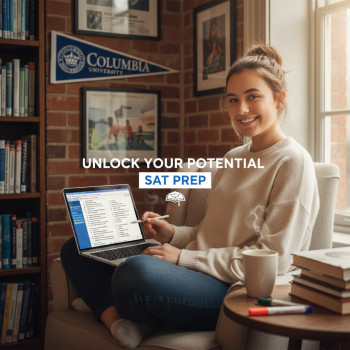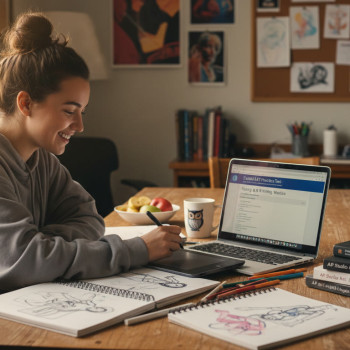Introduction: Why Screen Time Rules Matter for Digital SAT Success
Preparing for the Digital SAT feels different than it did a few years ago. The test is delivered on digital devices, practice is often online, and study resources live inside apps and websites. That opens up great advantages—practice that’s adaptive, instant feedback, built-in calculators, and flexible scheduling. It also introduces a new challenge: how do parents manage screen time in a way that supports serious SAT preparation without turning every device into a distraction factory?
This guide is written for busy parents who want straightforward, humane, and research-aware strategies you can put into practice this week. You’ll find practical rules to set, rhythms to adopt, simple tech setups, and conversational scripts to use with your student. You’ll get checklists, a sample weekly schedule, and one data table to help clarify trade-offs. And because some families benefit from expert help, we’ll note how Sparkl’s personalized tutoring—with 1-on-1 guidance, tailored study plans, expert tutors, and AI-driven insights—can naturally fit into a balanced screen plan when it makes sense.
Start with a Conversation, Not a Crackdown
Why empathy wins
Before you set rules, invite your student into the conversation. Adolescents often respond better to a plan they helped shape. Start by asking open questions: How does digital practice feel? When do they feel most focused? What distracts them most during study sessions? Framing the discussion as teamwork—your goal is shared: earn the best score with the least burnout—builds trust and improves buy-in.
Sample script to open the conversation
“I want to help you prepare for the Digital SAT without making study feel punishing. Let’s map out tools and boundaries that keep you focused. What works for you?”
Design Practical Screen Time Rules That Respect Study Needs
Three principles to guide rule-making
- Focus windows over total hours: Prioritize high-quality, distraction-free study blocks rather than an arbitrary time cap.
- Context matters: Different activities deserve different rules (practice tests vs. video lessons vs. messaging friends).
- Flexibility with accountability: Rules should be clear, but adjustable based on progress and stress—review weekly.
Concrete rules that work
- Study Device Rule: Use a single dedicated device for SAT study (laptop/tablet) and keep your phone in another room or on Do Not Disturb during focus windows.
- Focus Windows: 45–60 minute study blocks followed by a 10–15 minute break (Pomodoro-style), with one longer break after 3–4 blocks.
- Practice-Test Day: On full-length Bluebook practice tests, allow the device for the test only; no social apps or tabs during the session.
- Evening Cutoff: No SAT study screens within 60–90 minutes of bedtime to protect sleep and memory consolidation.
- Social Media Buffer: If a study block precedes or follows social time, use a 5-minute transition activity (walk, glass of water) to reset focus.
Set Up the Right Environment: Tech and Tidy Space
Device setup checklist
- Create a clean desktop with only the practice app or browser tab, notes, and a timer visible.
- Turn on Do Not Disturb or use focus modes that block notifications during study periods.
- Enable site or app blockers if temptation is strong—schedule allowed windows for social apps instead of constant access.
- For full practice tests, replicate test conditions (Bluebook app when practicing the official digital test) to build comfort with the format.

Physical space matters
Clear the study area of clutter, create a comfortable chair and lighting, and make sure the room is temperature-controlled. Small comforts—proper lighting, a filled water bottle, an extra pencil—reduce friction so study sessions are more likely to be sustained.
Build a Study Schedule That Balances Screen and Offline Practice
Why offline practice still matters
Even for a digital test, offline study is powerful. Paper-based scratchwork, spoken explanations, flashcards, whiteboard summaries, and timed handwriting drills build mental habits that translate into clearer thinking during a digital test.
Sample weekly schedule (high school junior aiming to test in fall)
| Day | Morning (before school) | Afternoon/Evening |
|---|---|---|
| Mon | 20–30 min quick review (offline flashcards) | 1 focus block digital practice (math) + 10 min reflection |
| Tue | Read a short article (paper/print) | 2 focus blocks: reading & grammar practice online, then 15 min handwritten notes |
| Wed | Mnemonic review (offline) | 1 full-length sectional practice (Bluebook) or timed set + rest |
| Thu | Vocabulary review (offline) | 1 focus block: problem sets, review mistakes |
| Fri | Light reading or free time | 2 short practice blocks, social time after study ends |
| Sat | Practice test every 2–3 weeks (digital, Bluebook) | Review answers offline, discuss mistakes together |
| Sun | Rest + light planning | Set study goals for the week |
Mix High-Tech Tools with Low-Tech Habits
Smart uses of technology
- Official digital practice (Bluebook and My Practice) for authentic test experience.
- Khan Academy-style personalized plans for targeted skill work—let the platform show weaknesses, but check the time spent there.
- Screen timers and focus apps for structured blocks (set them together so the student owns the tool).
- Use analytics—if your practice tool gives progress graphs, schedule a short weekly review to celebrate gains and adjust focus areas.
Low-tech strategies that improve retention
- Rewrite key math formulas or grammar rules by hand. The act of writing strengthens recall.
- Explain a solved problem out loud to a parent or to an imaginary audience—teaching reveals gaps.
- Paper flashcards for vocabulary and quick review. Keep a small stack in a backpack for micro-study moments.

When to Use Professional Help: Where Sparkl Fits In
Signs your student could benefit from tutoring
- Progress plateaus despite steady effort and practice.
- Study time is inefficient: lots of hours but low score gains or recurring mistakes.
- Test anxiety or inconsistent performance on practice tests.
How personalized tutoring supports balanced screen habits
Professional tutors can deliver focused, efficient study sessions that reduce wasted screen time. For example, Sparkl’s personalized tutoring model—1-on-1 guidance, tailored study plans, expert tutors, and AI-driven insights—can identify exactly which content areas need work so study sessions are shorter and more effective. Tutors can also teach test-taking strategies, model how to use digital practice tools efficiently, and recommend bespoke screen-time rules that match the student’s learning rhythm.
Track Progress Without Adding Pressure
Use data kindly
Quantitative progress—practice-test scores, error patterns, pacing metrics—is vital, but how you present that data at home matters. Frame metrics as fuel for improvement: identify one small change to try each week instead of reacting to every dip on the score chart. Celebrate small gains (better timing on math, fewer careless errors) as they compound quickly.
Weekly family check-in template
- Start with wins: What went well this week?
- Look at one metric: percent correct in one content area or timing improvement.
- Choose one action for next week: e.g., “We’ll do three 45-minute math blocks and one sectional test.”
- Adjust screen rules if necessary: Maybe shorten or lengthen focus blocks based on energy levels.
Addressing Common Challenges
Challenge: “My teen says studying on a phone is faster—should I allow it?”
Short answer: prefer a larger screen for authentic practice. Phones can be handy for micro-review, but practice tests and many prep platforms are designed for tablets or laptops. A bigger screen reduces navigation friction, allows comfortable scratchwork beside the device, and better simulates test conditions.
Challenge: “They get distracted the second they open the laptop.”
Try pairing an autofocus strategy with physical ritual: close all irrelevant tabs, put the phone away, and start with a 2-minute breathing exercise. Consider accountability partners: a 25-minute shared study call with a friend or tutor (video off) can help sustain focus.
Challenge: “Study is taking over weekends—how do we keep balance?”
Set a firm cap on weekend study hours, prioritize quality over quantity, and schedule guilt-free family time. On long practice-test days, plan a rewarding activity afterward to restore motivation and mental energy.
Sleep, Nutrition, and Movement: The Non-Screen Trio That Boosts Scores
Why these matter
Memory consolidation, focus, and reaction time depend heavily on sleep and physical wellbeing. No amount of screen-centered studying can replace a consistent bedtime, good hydration, and movement breaks. These off-screen habits are especially important for students preparing for a cognitively demanding exam like the Digital SAT.
Simple daily checklist
- 7–9 hours of sleep nightly (adjust for age and individual needs).
- Three balanced meals with healthy snacks during long study days.
- Short movement breaks every 60 minutes—stretch, walk, or do 5 minutes of light exercise.
Sample Family Agreement: Clear, Kind, and Flexible
Use this template to create a written plan. Have everyone sign it and agree to revisit after two weeks.
- Study Device: We agree that the student will use [device name] for SAT study and keep the phone in [location] during focus windows.
- Focus Blocks: We will do 45–60 minute focus blocks with 10–15 minute breaks. No social apps during blocks.
- Practice Tests: Full-length practice tests will be taken in the mornings on Saturdays every 2–3 weeks.
- Health: Study ends 60 minutes before bedtime; movement and meals will be prioritized.
- Check-ins: We will have a 15-minute family check-in on Sundays to adjust the plan.
Measuring What Matters: A Short Data Table to Clarify Trade-offs
| Approach | Pros | Cons |
|---|---|---|
| High screen time, unstructured | Lots of exposure to practice questions; flexible | High distraction risk, low retention, burnout |
| Structured screen time with offline balance | Focused gains, better retention, sustainable | Requires planning and initial habit building |
| Low screen time, mostly offline | Good for memory and rest, reduced fatigue | May not reproduce test conditions; less adaptive practice |
When to Reassess the Rules
Revisit the plan after any of these events: a big score jump, a plateau of more than four weeks, a change in test date, or increased stress symptoms (trouble sleeping, persistent headaches, or anxiety). The best rules are the ones that evolve with the student.
Final Tips: Kindness, Consistency, and Small Wins
- Celebrate progress. Small, visible rewards for steady effort work better than grand punishments for missed sessions.
- Be the model. If you’re asking for device-free dinners, try putting your own devices away too.
- Normalize help. If time is tight or stress is high, consider professional support. Tutors and structured programs can make study time more efficient—and when they’re targeted, they reduce the amount of screen time required to see results.
Closing: A Partnership Toward Confidence
Managing screen time for Digital SAT study isn’t about strict control; it’s about shaping an environment where focused practice can thrive alongside rest, family life, and healthy routines. The goal is a confident student who can use digital tools intentionally, not be ruled by them. With clear rules made together, a mix of digital and offline practice, and occasional expert help when needed—such as Sparkl’s personalized tutoring to sharpen weak spots—you can turn the challenge of digital preparation into a growth opportunity for the whole family.
Quick Start Checklist (One-Page Summary)
- Have a family conversation and co-create rules.
- Choose a dedicated study device; put phones away during focus windows.
- Use 45–60 minute focus blocks with short breaks (Pomodoro-style).
- Mix digital practice (Bluebook, Khan-style practice) with offline methods.
- Schedule full practice tests every 2–3 weeks under test-like conditions.
- Prioritize sleep, movement, and nutrition.
- Do a weekly check-in: celebrate gains, set one targeted action.
- Consider 1-on-1 tutoring if progress stalls—targeted help often reduces total screen hours needed.
Good luck—and remember: small, steady changes beat frantic, last-minute pivots. You and your student can create a study rhythm that respects attention, health, and academic goals. If you want, try this plan for two weeks and then tweak the rules together. It usually gets easier from there.














No Comments
Leave a comment Cancel